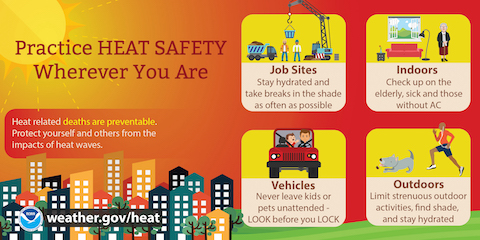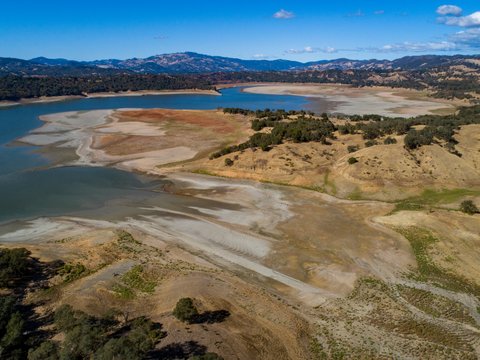
04 Jun State Offers Resources, Tips to Deal With Extreme Heat

(National Weather Service via Bay City News)
By Tony Hicks
Bay City News
Gov. Gavin Newsom on Tuesday highlighted the state’s continued preparedness and response efforts to this week’s heat wave and urged Californians to protect themselves from extreme heat.
According to the National Weather Service, temperatures in the Central Valley may reach up to 105 degrees, with Death Valley National Park likely reaching 118-121 degrees.
The heat has prompted the state to enter phase 2 of its Extreme Temperature Response Plan, at least through Thursday, triggered by weather service predictions of excessive heat activity, and moves the state into action to coordinate an all-hands response by the state government.
Newsom’s office released a statement saying the changing climate is making heat waves more intense and frequent and extreme heat kills more Americans each year than any other extreme weather events, including wildfires, droughts, and floods.
Last month, Newsom announced the launch of ready.ca.gov, a new one-stop shop for Californians to prepare for emergencies and extreme weather. The new website is part of Listos California, a state plan to connect communities with in-language resources before, during and after emergencies.
The California Governor’s Office of Emergency Services is coordinating with local governments and emergency managers on regional needs. A current list of local cooling centers open by county can be found at https://news.caloes.ca.gov/coolingcenters.
Through Listos California, Cal OES is deploying in-language preparedness messaging to California’s most impacted communities and those who may be most at risk during extreme temperatures, including those 65 years of age or older; people with chronic illness, disabilities or who are pregnant.
>>>Read: With Climate Change, Comes More Potential Complications for People with Lupus
The California Division of Occupational Safety and Health reminds employers to protect workers from heat illness during high temperatures by providing water, rest, shade and training.
Field inspectors are conducting targeted inspections at worksites where workers are most vulnerable to heat illness, including in agriculture and construction. Details on heat illness prevention requirements and training materials are available online at 99calor.org.
The California Department of Public Health has created a heat and summer safety toolkit to provide resources and communication tools to be shared, at https://www.cdph.ca.gov/Programs/OPA/Pages/Communications-Toolkits/Heat-Summer-Safety.aspx.
CDPH also develops heat guidance for schools, local health jurisdictions, and other community service providers to protect Californians, particularly heat-vulnerable populations like children, students, older adults, the unhoused, outdoor workers, and those with existing health conditions.
State officials say to stay cool during the hottest times of day. Those without air conditioning should check with their city or county for cooling centers or visit public locations such as a library or shopping mall.
Officials also advise to avoid physical exertion or exercising outdoors when it’s too hot. Wear lightweight, light colored, loose clothing, hats, sunglasses and sunscreen. Stay hydrated. Drink plenty of fluids, especially water, even when not thirsty; drink sports drinks (in moderation with water) to help replace electrolytes lost during exercise.
Avoid sugary, alcoholic, and very cold drinks. Eat plenty of fruit and vegetables.
State officials also say to stay connected. Monitor those at high risk of heat-related illness including infants and young children; people 65 years of age or older; individuals with chronic illness, disabilities or who are pregnant.
Californians are also encouraged to check on their neighbors — call or visit vulnerable people and offer to pick up groceries, medication, and other necessities. Older adults, young children and babies, people with chronic medical conditions and those who are pregnant are most vulnerable. Use a buddy system when working in the heat.
Find more information at https://www.listoscalifornia.org.
Copyright © 2024 Bay City News, Inc. All rights reserved. Republication, rebroadcast or redistribution without the express written consent of Bay City News, Inc. is prohibited. Bay City News is a 24/7 news service covering the greater Bay Area.






No Comments